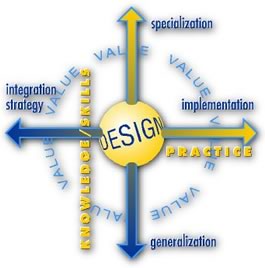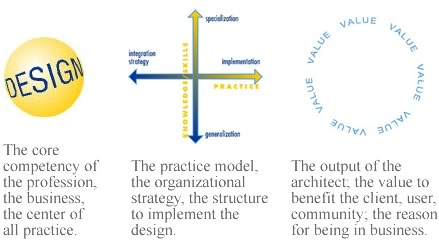

by Richard W. Hobbs, FAIA
Resident Fellow, Marketplace Research and Trends
In his book The Tipping Point, Malcolm Gladwell defines "tipping point" as a threshold, a boiling point, or a moment of critical mass. It seems to me that we have reached a tipping point in accepting the role of the architect as an Integrated Service Provider, if recent feedback to my column is any measure. Many of the architects who responded have found interesting ways to provide alternative services that increase their design opportunities. Others provide services not directly related to a building. Here are their stories.
Image integrator: Paul Chaplo, AIA, (www.chaplo.com) is an architectural photographer who sees himself as a coordinator and integrator of imaging and presentation services and products. He is not taking photos, he says. Rather, he is expressing the emotion, spirit, and strategy of a client.
 Matrix
builder: Tim Culvahouse, AIA, says that the two-dimensional redefinition
matrix may be unduly constraining for the ideas it is trying to show.
He points out that architecture as a practice is at least four dimensions.
He also believes that the matrix is neutral in terms of value—and
the final measure of our work is the value, or quality produced. Culvahouse
brings up the thought that integrated services—or any services at
all—may not have anything to do with good design, especially services
increasingly distant from design. (Others argue that nothing is distant
from design, because "it's all design," and that integrated
services support an even more complete design.)
Matrix
builder: Tim Culvahouse, AIA, says that the two-dimensional redefinition
matrix may be unduly constraining for the ideas it is trying to show.
He points out that architecture as a practice is at least four dimensions.
He also believes that the matrix is neutral in terms of value—and
the final measure of our work is the value, or quality produced. Culvahouse
brings up the thought that integrated services—or any services at
all—may not have anything to do with good design, especially services
increasingly distant from design. (Others argue that nothing is distant
from design, because "it's all design," and that integrated
services support an even more complete design.)

Streamlining the design process: Scott Shaw, AIA, reports that ISPs, professional responsibility, and "negentropy" are concepts that architects seem to be putting to work all over the Northwest and Pacific Region, almost as a byproduct of the search for a more streamlined design process. He states that architects facilitate connections with the community to get work and get work for those we respect. We facilitate "gentropy" by encouraging participation, and " team" interaction through all phases of the design/construction process. It's all about making connections to the communities in which we work and live, Shaw says.
Benefiting clients: Over the last 25 years, Isaac Molina, AIA, has seen clients defining design as "style." When you think about it, he says, that's a very narrow service. He has "unexplained" to clients that design is a process they absolutely need to protect their investment in the project. He finds that once you educate the client on benefits of the architect as an integrated service provider, it becomes an obvious cost-effective insurance policy for them. His 10-year success at working in this manner is an indication that "if you can get in front of potential clients, they seem to take notice."
Right from the start: CH2M Hill and its Eco-Charrettes managed by Nathan Good, AIA, IIDA. (See AIArchitect, Best Practices, June 17) offer a good example of architect involvement from the outset. As the facilitator for integrated design workshops, it is not uncommon that the firm's involvement is with clients who have not selected their architect or design team. They are involved in the genesis, the definition of the design issue or project—way before the cocktail napkin phase.
A synergistic model: Page Sutherland Page, (www.psp.com) a 100-year-old firm, began a major shift in 1993 when they created a strategic consulting group under the direction of Kurt Neubek, AIA. They developed a synergy of strategy and architecture in each area of expertise: health care, education, science technology, and laboratories. Each of the expertise areas has its own vocabulary and issues in which the firm is now a knowledge leader. It has paid off. When Baylor College of Medicine needed an immediate facility-management process for their campuses, PSP stepped up to provide this in a stopgap method and, in turn, set up the entire campus.
Each of these architects has shifted his firm toward being an ISP and says that this shift offers greater value to clients and to the firm in turn. We will share their different strategies for making shift in the near future.
The evolving role
of architects
The Experience Economy by Pine
and Gilmore talks about how we have evolved from a raw materials economy
(the '40s), to a goods economy (the '50s) to a service economy (the '70s)
to the experiences economy (the '90s). It is worth looking at to see how
the role of the architect has changed into one of "thinking how the
user thinks." As one example, John Eberhard, FAIA, AIA Research,
relates this notion to research by the AIA and the National Association
of School Boards on educational environments:
• 1940s (raw materials stage): Classrooms had seats and blackboards
were arranged in set patterns.
• 1955 (goods stage): Classrooms were designed as adaptable spaces
that could be changed around by teachers (but rarely were).
• 1970 (service economy): Classrooms became places where "free-ranging"
children did what they pleased and for whom the teachers provided "stimulation"
as their service in the design.
• 1990s (experience economy): Architects need to think the way the
teacher thinks when he or she is providing a learning experience for the
student and in what way the physical environment of "classroom"
supports the teachers in providing this experience.
Copyright 2002 The American Institute of Architects. All rights reserved.
![]()
|
Respond to the author by email. The author would like to acknowledge the research resources contributed by the Wallace Research Group Coming up in this column August: Research to further understand behavior systems with integrated teams of architects and clients September: Becoming an Integrated Service Provider through the strategic alliance model October: A report on the September 17 Committee on Architects for Education PIA conference's education client/architect think tanks |
|